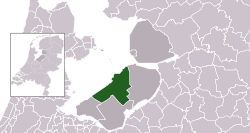Lelystad
| Lelystad | |||
|---|---|---|---|
| City and Municipality | |||

Lelystad city centre
|
|||
|
|||
 Location in Flevoland |
|||
| Coordinates: 52°30′N 5°29′E / 52.500°N 5.483°ECoordinates: 52°30′N 5°29′E / 52.500°N 5.483°E | |||
| Country | Netherlands | ||
| Province | Flevoland | ||
| Established | 1 January 1980 | ||
| Government | |||
| • Body | Municipal council | ||
| • Mayor | Margreet Horselenberg (PvdA) | ||
| Area | |||
| • Total | 765.45 km2 (295.54 sq mi) | ||
| • Land | 231.54 km2 (89.40 sq mi) | ||
| • Water | 533.91 km2 (206.14 sq mi) | ||
| Elevation | −3 m (−10 ft) | ||
| Population (May 2014) | |||
| • Total | 76,285 | ||
| • Density | 329/km2 (850/sq mi) | ||
| Time zone | CET (UTC+1) | ||
| • Summer (DST) | CEST (UTC+2) | ||
| Postcode | 8200–8249 | ||
| Area code | 0320 | ||
| Website | www |
||
Lelystad (Dutch: [ˈleːlistɑt]) is a municipality and a city in the centre of the Netherlands, and it is the capital of the province of Flevoland. The city, built on reclaimed land, was founded in 1967 and was named after Cornelis Lely, who engineered the Afsluitdijk, making the reclamation possible. Lelystad is approximately 3 metres (9.8 feet) below sea level.
Lelystad is built on the seabed of the former Zuiderzee. About 6500 years ago this wetland was above high tide level and inhabited; the Netherlands have steadily subsided since. Near Lelystad at Swifterbant, the oldest human skeletons in Western Europe were discovered. Due to rising water levels and storms, the peatlands were washed away, and the Lacus Flevo (in Roman times) grew to be the Almere (Middle Ages) and became the Zuiderzee. The Zuiderzee (Southern Sea) was the main transport route from Amsterdam to the North Sea and the Hanseatic League cities. Due to the many shipwrecks in Flevoland, Lelystad now houses the National Centre for Maritime History, with a museum and the shipyard that has built the Batavia replica.
After the Second World War the Zuiderzee Works continued, constructing the polder of Eastern Flevoland. In 1950 work commenced on several construction islands in the middle of the IJsselmeer. Lelystad-Haven was the largest island, and its wooden barracks housed a community of dyke-builders. In 1955 they reached the mainland, which made it possible to drive to Lelystad by car. One of the three pumping stations, which drained the polder in June 1957, was the diesel-powered Wortman in Lelystad-Haven. Until 1967 the only inhabitants of Lelystad were technical engineers and laborers and superintendents, living on the former construction island.
...
Wikipedia


